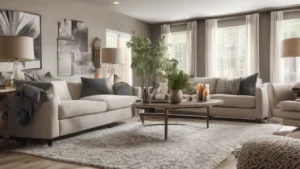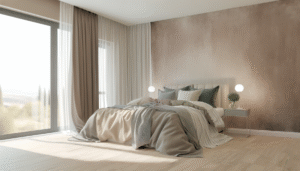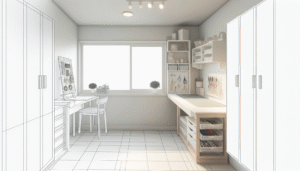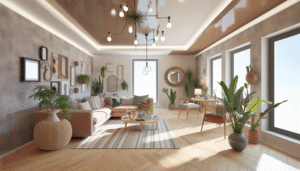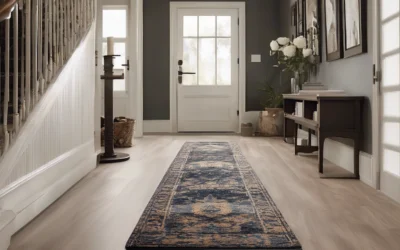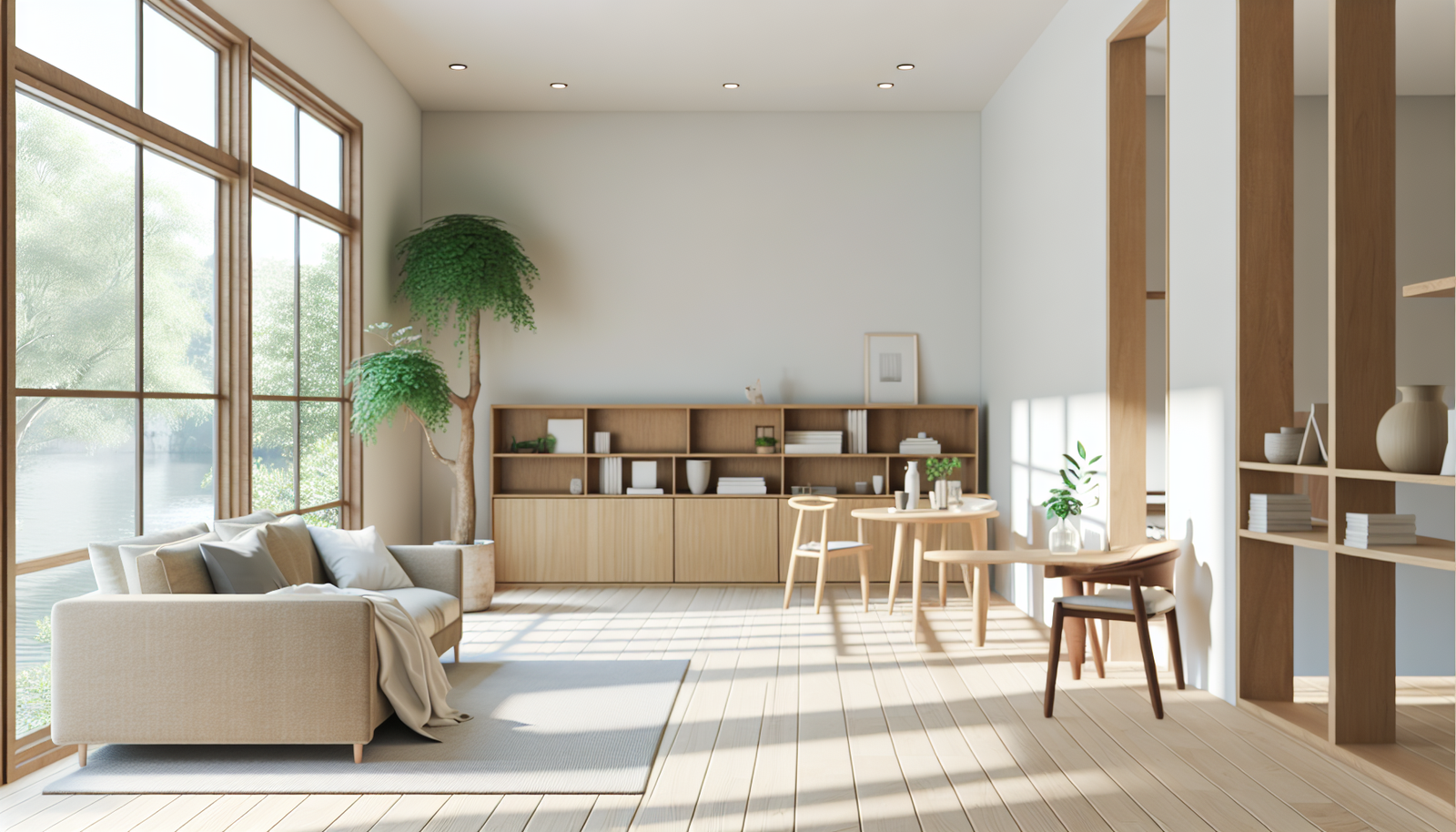
Imagine walking into a room that immediately calms your mind. No clutter, no jarring colors, just an effortless sense of peace and purposeful design. This isn’t just a dream; it’s the essence of Japandi aesthetics, and nowhere is this more impactful than in your choice of Japandi minimalist window treatments. These aren’t just coverings for your windows; they are integral architectural elements that sculpt light, define privacy, and contribute profoundly to the tranquil, uncluttered sanctuary that Japandi design promises.
Many homeowners wrestle with a familiar dilemma: how to achieve privacy and light control without sacrificing aesthetic appeal. Heavy drapes can feel suffocating, while flimsy blinds lack character. The challenge intensifies when you aspire to a modern, serene interior. This article cuts through the confusion, offering a comprehensive guide to understanding, selecting, and integrating the perfect Japandi minimalist window treatments into your home. We’ll explore how to harness the fusion of Japanese tranquility and Scandinavian utility, transforming your windows into sources of both light and inspiration. Get ready to elevate your living spaces with solutions that are as beautiful as they are practical.
What is Japandi Design? A Holistic Philosophy for Your Home
Before we dive into the specifics of window treatments, let’s lay the groundwork. What exactly is Japandi, and why has this aesthetic captured the hearts of design enthusiasts worldwide? Japandi is more than just a trend; it’s a profound design philosophy born from the harmonious convergence of Japanese wabi-sabi and Scandinavian hygge (and lagom). It’s a celebration of imperfection, natural materials, clean lines, and functional beauty. The result is a design style that feels both grounding and refreshingly modern.
The Core Tenets of Japandi: Wabi-Sabi Meets Hygge
At its heart, Japandi design champions a few fundamental principles:
- Simplicity & Minimalism: Eliminate clutter. Every item must have a purpose or bring profound joy.
- Natural Materials: Wood (especially light oak or darker walnut), bamboo, linen, cotton, stoneware, and paper are staples.
- Neutral Color Palettes: Think muted tones—soft grays, warm whites, earthy browns, subtle greens, and charcoal—punctuated by occasional deep blacks or natural wood hues.
- Craftsmanship & Quality: Invest in fewer, better things. Appreciate the handmade and the enduring.
- Functionality & Comfort: Spaces are designed to be lived in, offering both practical utility and a sense of cozy well-being.
- Connection to Nature: Bring the outdoors in through plants, natural light, and organic textures.
Consider the delicate balance. Japanese design often prioritizes sleek lines and spiritual tranquility, while Scandinavian design emphasizes comfort, warmth, and practicality. Japandi seamlessly blends these, creating interiors that are both refined and inviting. This dual focus directly impacts the choices we make for Japandi minimalist window treatments.
Why Window Treatments Are Central to Japandi Minimalism
In a design philosophy so dedicated to intentionality and impact, window treatments are far from an afterthought. They are critical players in defining the atmosphere, controlling natural light, ensuring privacy, and unifying the overall aesthetic of a Japandi space. Incorrect choices can easily disrupt the delicate balance of tranquility and functionality.
Sculpting Light: The Essence of Japandi Ambiance
Light is a fundamental element in both Japanese and Scandinavian design. Japanese architecture often uses screens and translucent materials to filter and diffuse light, creating soft, ethereal glows. Scandinavian design, hailing from regions with limited daylight, maximizes every ray. Japandi minimalist window treatments must excel at this delicate dance—allowing abundant natural light to penetrate while also softening harsh glares and providing privacy when needed.
- Diffusion over Obstruction: The goal isn’t to block light entirely, but to modify it.
- Dynamic Control: The ability to adjust light levels throughout the day is paramount.
- Atmospheric Impact: Filtered light creates a serene, shadow-play effect that enhances calm.
Privacy & Connection: Striking the Balance
In our increasingly connected world, the need for a private sanctuary is more important than ever. Japandi design acknowledges this. Window treatments provide that necessary retreat from the outside world without making a room feel isolated. They offer a sense of security and intimacy, allowing you to control your visual connection to the exterior environment. This allows for both moments of quiet contemplation and openness to the natural world. Effective Japandi minimalist window treatments achieve this duality effortlessly.
Visual Harmony: Integrating with the Minimalist Aesthetic
Every element in a Japandi room is chosen with purpose. Clutter is the enemy, and unnecessary ornamentation is avoided. This applies directly to your windows. Treatments should recede into the background, complementing the existing decor rather than dominating it. They should reflect the clean lines, natural textures, and muted color palette characteristic of the style. This means prioritizing:
- Unobtrusive Design: Simple forms, minimalist hardware.
- Natural Textures: Materials that feel organic and inviting.
- Cohesive Colors: Shades that blend seamlessly with walls and furnishings.
Ultimately, these treatments are not just design accessories; they are functional artworks that encapsulate the core values of Japandi. When chosen wisely, they can significantly enhance the sense of calm and order in your home.
Types of Japandi Minimalist Window Treatments: Your Essential Guide
With an understanding of Japandi’s ethos, let’s explore the specific window treatment options that best embody this aesthetic. From traditional Japanese influences to Scandinavian innovations, each type offers unique benefits for light control, privacy, and visual appeal. Choosing the right one depends on your specific needs, window type, and the overall feel you want to achieve.
1. Shoji Screens & Panel Blinds: The Epitome of Japanese Serenity
When you think of traditional Japanese interiors, shoji screens often come to mind. These iconic panel screens, typically framed in wood and covered with translucent paper, are a quintessential example of diffused light and minimalist elegance. Modern adaptations, often called panel track blinds or sliding panels, offer a similar aesthetic with increased durability and contemporary material options.
Pros:
- Superior Light Diffusion: Creates a soft, warm glow without harsh glare, maintaining privacy.
- Architectural Statement: Acts as a striking, yet understated, focal point.
- Clean Lines: Large, flat panels offer an exceptionally sleek look.
- Versatility: Can be used for large windows, patio doors, or even as room dividers.
Cons:
- Cost: Can be a more significant investment, especially custom wood frames.
- Limited View: While they diffuse light, they can restrict an unobstructed view.
- Cleaning: Fabric/paper panels may require delicate care.
Japandi Application:
Ideal for creating a strong Japanese influence. Opt for light wood frames (like bamboo or light oak) and natural-toned translucent fabrics or rice paper for an authentic touch. They are perfect for achieving a tranquil, spa-like atmosphere in living rooms, bedrooms, or meditation spaces. Think about how the light filters through, creating beautiful moving shadows throughout the day. These are truly immersive Japandi minimalist window treatments.
2. Roller Blinds & Shades: Scandinavian Simplicity & Efficiency
Roller blinds are the embodiment of Scandinavian practicality. Their clean, unfussy design disappears almost entirely when raised, maximizing light and views, and offers a crisp, flat panel when lowered. Advancements in materials mean you can find roller blinds in a vast array of textures and opacities, from sheer to blackout.
Pros:
- Unobtrusive Design: Minimalist by nature, they recede into the window frame when not in use.
- Excellent Light Control: Available in sheer, light-filtering, and blackout options.
- Affordability: Generally more budget-friendly than other custom options.
- Durability & Easy Maintenance: Many modern fabrics are easy to clean.
- Motorization Available: For ultimate convenience and smart home integration.
Cons:
- Limited Texture: Some find plain roller blinds too stark; texture becomes key.
- Side Gaps: Unless precisely fitted, small gaps at the sides can allow light leakage.
Japandi Application:
Choose roller blinds in natural linen or textured fabrics in muted tones (off-white, light gray, sand). Look for discreet hardware and perhaps a bottom bar in a matching or complementary muted metal. They are perfect for rooms where you want maximum flexibility in light and privacy, such as kitchens, home offices, or bedrooms where you need full darkness. Their clean lines are inherently Japandi.
3. Roman Blinds & Shades: Softness with Structure
Roman blinds offer a beautiful compromise between the structured appearance of panel blinds and the softness of fabric. When raised, they fold neatly into soft, horizontal pleats, adding a touch of tailored elegance. When lowered, they present a flat or softly pleated fabric panel. The key to Japandi styling here is fabric choice and avoiding excessive ornamentation.
Pros:
- Soft Visual Impact: Adds warmth and texture without being bulky.
- Tailored Look: Appears sophisticated and custom-made.
- Versatile Fabrics: Available in a wide range of natural materials and opacities.
- Good Insulation: Fabric layers can add a degree of thermal insulation.
Cons:
- Stacking Headrail: When fully open, fabric can stack at the top, slightly reducing the top portion of the window view.
- Cleaning: Fabric may require professional cleaning depending on material.
- Less Precise Light Control: Compared to Venetian or cellular blinds, it’s either open or closed (mostly).
Japandi Application:
Select Roman blinds in natural fibers like linen, cotton, or a subtle jute blend. Earthy tones, soft grays, and warm whites work best. Mount them inside the window frame for a cleaner, built-in look, or outside with a minimalist valance if you need to conceal the mechanism and maximize glass exposure. Avoid fussy trims or patterns. These are refined Japandi minimalist window treatments that add a layer of inviting texture.
4. Wooden Venetian Blinds: Classic Control with Natural Warmth
Wooden Venetian blinds, particularly those with wide slats, are a strong contender for Japandi interiors. They offer unparalleled control over light and privacy by allowing you to angle the slats. The natural wood introduces warmth and an organic texture that aligns perfectly with the Japandi emphasis on natural materials.
Pros:
- Excellent Light & Privacy Control: Slats can be angled precisely.
- Natural Material: Wood adds warmth, texture, and a connection to nature.
- Durable: High-quality wood blinds are long-lasting.
- Timeless Appeal: Never goes out of style.
Cons:
- Dust Accumulation: Slats can attract dust and require regular cleaning.
- Can Appear Heavy: Especially if too dark or with narrow slats; choose wide, lighter slats.
- Obstructed View: Even when fully open, the stacked slats will slightly obstruct the view.
Japandi Application:
Opt for wooden Venetian blinds in light, natural wood tones like birch, ash, or a light oak finish. Avoid overly glossy finishes; a matte or subtle satin sheen is more appropriate. Keep the hardware simple and unobtrusive. These are fantastic for blending the practical control of Scandinavian design with the organic feel of Japanese aesthetics, proving themselves excellent Japandi minimalist window treatments.
5. Cellular & Pleated Shades: Subtle Texture & Energy Efficiency
Cellular shades (also known as honeycomb shades) are admired for their unique honeycomb structure, which provides excellent insulation, making them energy-efficient. Pleated shades offer a similar minimalist aesthetic with a single layer of pleated fabric. Both provide a soft, diffused light when closed and disappear neatly when raised.
Pros:
- Energy Efficiency: Honeycomb cells trap air, insulating windows.
- Clean & Unobtrusive: Folds or stacks very compactly.
- Soft Light Filter: Creates an even, diffused light.
- Top-Down/Bottom-Up: Offers flexible privacy and light control.
Cons:
- Texture Limitations: Fabric options are typically more uniform than Roman or roller blinds.
- Cleaning Internal Cells: Dust can accumulate inside cellular shades.
Japandi Application:
Choose cellular or pleated shades in very subtle, muted tones – soft grays, off-whites, or light beige. Look for fabrics with a slight linen-like texture to prevent them from looking too synthetic. Their discreet nature and energy-saving properties align perfectly with Japandi’s functional emphasis. The top-down/bottom-up feature is particularly Japandi-friendly, allowing you to maintain privacy while welcoming natural light from above.
6. Woven Wood Shades & Bamboo Blinds: Organic Textures & Eco-Consciousness
Woven wood shades, often made from bamboo, jute, reeds, or grasses, bring an incredibly organic, tactile dimension to a window. They offer a unique interplay of light and shadow, filtering light through their natural weave. They are a natural fit for Japandi design’s love for organic materials and connection to nature.
Pros:
- Rich, Natural Texture: Adds warmth and depth that synthetic materials cannot replicate.
- Eco-Friendly: Often made from sustainable, rapidly renewable resources.
- Varied Light Filtering: Weaves can range from open to tightly woven for different light levels.
- Distinctive Aesthetic: Creates a unique, handmade feel.
Cons:
- Less Precise Light Control: Light filtering is inherent to the weave, not fully adjustable like slats.
- Limited Blackout: Often require a privacy or blackout liner for full light blockage.
- Can be Fragile: Some weaves can be delicate.
Japandi Application:
Select woven wood shades in neutral, un-dyed tones to let the natural material shine. Consider adding a plain privacy liner for bedrooms. These shades are excellent for living areas, dining rooms, or sunrooms where you want to emphasize the connection to the outdoors and infuse organic texture. They embody the wabi-sabi appreciation of natural imperfection and are essential Japandi minimalist window treatments.
Selecting Materials, Colors, and Finishes: The Japandi Palette
The success of your Japandi minimalist window treatments hinges on choices that extend beyond the style of covering. Material, color, and finish are equally crucial in creating coherence and achieving that coveted serene atmosphere. This is where the Japandi philosophy truly shines through, demonstrating that less is indeed more, and quality trumps quantity.
The Japandi Material Manifesto
Natural materials are the bedrock of Japandi design. They introduce texture, warmth, and an organic connection to the environment, aligning with both Japanese reverence for nature and Scandinavian appreciation for longevity. For your window treatments, prioritize:
- Linen: Known for its beautiful drape, subtle slubs, and durability. Linen offers a relaxed yet refined look.
- Cotton: A versatile and breathable choice. Opt for organic, untreated cotton or blends for a natural feel.
- Bamboo: Sustainable, lightweight, and inherently beautiful. Perfect for woven shades and some panel applications.
- Wood: Light-toned woods like birch, ash, or light oak for Venetian blinds, or darker walnut for a sophisticated contrast.
- Rice Paper/Washi: For authentic shoji screens, offering unparalleled light diffusion and a delicate aesthetic.
- Jute & Reed: For woven shades, providing robust texture and an earthy feel.
Avoid synthetic, shiny, or overly processed materials. The goal is to evoke nature, not plastic.
Color Psychology: Muted & Earthy Tones
The Japandi color palette is deliberately subdued, designed to create a calm and restful environment. Your window treatments should echo this tranquility, preventing any visual jarring. Think about colors that don’t demand attention but rather support the overall sense of peace.
- Warm Whites & Off-Whites: Softer than stark white, they provide warmth without feeling cold.
- Soft Grays: From dove gray to a subtle charcoal, grays offer sophistication and neutrality.
- Earthy Browns & Beiges: Mimicking raw wood or sand, these add grounded warmth.
- Muted Greens: Think sage, moss, or subtle olive, connecting to natural foliage.
- Black & Dark Gray (Accents): Used sparingly for frames or hardware to add definition, without overwhelming.
The key is consistency. Ensure your chosen colors complement, rather than clash with, the rest of your interior scheme. These colors ensure your Japandi minimalist window treatments contribute to, not detract from, a cohesive calm.
Subtle Finishes: Matte, Brushed & Natural
Just as important as material and color is the finish. Japandi design shies away from anything overly polished or ornate. Instead, it embraces finishes that feel honest and natural.
- Matte Finishes: For wood, metal hardware, or even fabrics, matte absorbs light and creates a sophisticated, understated look.
- Brushed Metals: If using metal hardware (curtain rods, bottom bars), opt for brushed nickel, black matte, or bronze over shiny chrome or polished brass.
- Natural Textures: Embrace the inherent texture of linen, the grain of wood, or the weave of bamboo. These imperfections add character.
A natural, unfinished, or lightly oiled wood frame for shoji screens, for example, is far more Japandi than a heavily lacquered one. These details make all the difference in achieving an authentic look for your Japandi minimalist window treatments.
Key Considerations for Implementing Japandi Window Treatments
Choosing the right style, material, and color is only part of the equation. Successful integration of Japandi minimalist window treatments requires thoughtful consideration of functionality, installation, and overall impact within your space. These practical aspects ensure that your treatments not only look good but also perform optimally and enhance your daily living.
Light Control & Privacy Needs: A Dynamic Duo
Before making any purchasing decisions, honestly assess your light control and privacy requirements for each specific window. Do you need:
- Full Blackout: Essential for bedrooms, nurseries, or media rooms. Layering (e.g., a sheer Roman blind with a blackout roller behind it) can be a Japandi-friendly solution.
- Light Filtering/Diffusion: Perfect for living areas or dining rooms where you want to soften glare but retain brightness. Shoji screens, sheer roller blinds, or light linen Roman blinds excel here.
- Daytime Privacy, Nighttime View: Top-down/bottom-up cellular shades or adjustable wooden Venetians offer this flexibility.
- Minimal Obstruction: If you have a beautiful view, shades that roll up completely (like roller blinds) or are recessed into the ceiling are ideal.
Think about the direction your windows face (north, south, east, west) and how the sunlight shifts throughout the day. Your treatments should adapt to these natural rhythms.
Mounting & Hardware: The Unseen Details
In Japandi design, hardware should be as discreet as possible. It’s purpose is functional, not decorative. This makes a huge difference in the overall neatness of your Japandi minimalist window treatments.
- Inside Mount: Whenever possible, mount blinds or shades inside the window frame. This creates a clean, built-in look and lets any architectural trim around the window remain visible.
- Outside Mount: Use an outside mount if your window frame isn’t deep enough, or if you need to conceal the frame entirely (e.g., covering a less-than-perfect window trim). Ensure the treatment extends sufficiently beyond the frame to prevent light gaps.
- Concealed Hardware: Look for headrails that are discreetly covered by fabric or a minimalist valance. For panel tracks, choose slim, unobtrusive tracks.
- Minimalist Curtain Rods: If using curtains (a more challenging but not impossible Japandi choice), opt for thin, matte black or brushed metal rods with simple, cylindrical finials. Avoid ornate or decorative finials.
Layering for Versatility & Depth
While minimalism suggests simplicity, layering can actually enhance functionality and add subtle depth, especially when done thoughtfully. It’s about smart design, not clutter.
- Sheer with Blackout: A translucent roller blind for daily light filtering, paired with a hidden blackout roller blind for night.
- Woven Wood with Sheer Drape: A textured woven wood shade for organic daytime beauty, softened by a light, sheer linen curtain on a minimalist rod for added warmth during cooler months or extra privacy when desired.
- Shoji Screens with a Roman Blind: The shoji screens provide the main light diffusion and aesthetic, while a simple Roman blind offers an additional layer of thermal control or full light block when needed.
The key is that each layer serves a distinct purpose and contributes to the serene aesthetic, not distracting from it. These thoughtfully chosen layers elevate your Japandi minimalist window treatments.
Smart Home Integration: Modern Japandi Efficiency
Japandi design isn’t just about aesthetics; it’s about making daily life simpler and more pleasant. Motorized window treatments align perfectly with this philosophy. Imagine silently opening your blinds with a voice command, or having them automatically adjust with the sunrise and sunset.
- Convenience: Effortless control, especially for hard-to-reach windows.
- Energy Savings: Schedule treatments to close during peak sun hours to reduce heat gain in summer, or open to maximize passive solar heating in winter.
- Security: Automate movements to give the impression of an occupied home.
- Seamless Integration: Many systems integrate with popular smart home platforms like Google Home, Amazon Alexa, or Apple HomeKit.
Consider motorized options for roller shades, cellular shades, and even certain Roman blinds and panel tracks. This modern convenience elevates the functionality of your Japandi minimalist window treatments.
Common Pitfalls and How to Avoid Them in Japandi Window Styling
Even with the best intentions, it’s easy to make choices that inadvertently detract from the Japandi aesthetic. Avoiding these common mistakes will ensure your Japandi minimalist window treatments truly embody tranquility, functionality, and timeless style.
1. Over-Ornamentation: Too Much of a “Good Thing”
The biggest enemy of Japandi is clutter and unnecessary fuss. This applies directly to window treatments.
- The Pitfall: Choosing blinds with decorative valances, ornate finials, patterned fabrics, or overly elaborate trimmings. Heavy, voluminous drapes with tie-backs also fall into this category.
- The Japandi Fix: Embrace simplicity. Opt for clean lines, understated hardware, and unadorned fabrics. Let the material’s natural beauty and the treatment’s function be the “decoration.” If you use curtains, keep them simple, unlined, and in a natural fabric.
2. Ignoring Natural Light: Blocking vs. Filtering
Japandi celebrates natural light. Completely blocking it out (unless for specific, functional reasons) goes against the core philosophy.
- The Pitfall: Selecting only blackout blinds or very heavy, opaque treatments for all windows, or always keeping treatments fully closed.
- The Japandi Fix: Prioritize light-filtering or diffusing options. Think about sheer roller blinds, shoji screens, or translucent Roman blinds for areas where privacy isn’t paramount. For bedrooms, layer a light-filtering treatment with a hidden blackout one. The goal is to sculpt light, not obliterate it.
3. Neglecting Texture: The Invisible Element
Without patterns or bold colors, texture becomes paramount in Japandi design to add interest and warmth.
- The Pitfall: Choosing window treatments made from smooth, synthetic, or bland materials that offer no tactile or visual interest.
- The Japandi Fix: Embrace natural textures. Think slubby linen, lightly woven cotton, bamboo, or timber with visible grain. These textures add depth and organic beauty without relying on patterns. Even subtle woven patterns in monochromatic fabrics can add sophistication. This is a subtle but powerful way to enhance your Japandi minimalist window treatments.
4. Inconsistent Color Palettes: Breaking the Serenity
A calm, cohesive color scheme is vital for Japandi’s tranquil atmosphere.
- The Pitfall: Introducing bright, clashing, or overly saturated colors in your window treatments that disrupt the muted, earthy palette of the room.
- The Japandi Fix: Stick to the characteristic Japandi color scheme: warm whites, soft grays, earthy beiges, deep charcoals, and natural wood tones. Ensure the color of your window treatments complements your walls, furniture, and other textiles. The aim is harmony, not contrast.
5. Poor Fit & Installation: Functionality First
A poorly fitted or installed window treatment immediately compromises both aesthetics and function.
- The Pitfall: Window treatments that are too short, too narrow, hang unevenly, or have visible, messy cords or hardware.
- The Japandi Fix: Measure meticulously. Consider professional installation for custom-made Japandi minimalist window treatments, especially for large or irregularly shaped windows. Ensure cords are managed neatly (or opt for cordless/motorized versions). An inside mount, when feasible, always creates a cleaner, more integrated look.
6. Forgetting Maintenance: Longevity & Cleanliness
Japandi values quality and durability, which implies proper care.
- The Pitfall: Choosing delicate materials for high-traffic or high-moisture areas (like kitchens or bathrooms) that are difficult to clean, leading to quick wear and tear or a perpetually dusty look.
- The Japandi Fix: Consider the practical requirements of your space. For kitchens, easily wipeable roller blinds or faux wood Venetians might be more suitable than delicate linen. Commit to regular, gentle cleaning to maintain the pristine, calming aesthetic. Some materials like bamboo or certain synthetic blends are designed for easy maintenance.
Japandi Window Treatments: Room-by-Room Inspiration & Solutions
Applying the principles of Japandi minimalist window treatments isn’t a one-size-fits-all approach. Each room in your home presents unique challenges and opportunities regarding light, privacy, and function. Let’s explore tailored solutions to bring Japandi serenity to every corner.
Living Room: Creating a Balanced Sanctuary
The living room is often the heart of the home, a space for relaxation, gathering, and connection. Japandi window treatments here should support both open, airy connection to the outside and intimate comfort.
- Challenge: Balancing ample natural light with glare control and occasional privacy for evening relaxation.
- Solutions:
- Sheer Roller Blinds: Allow diffused light to pour in while minimizing glare. Combine with an underlying blackout roller if needed for movie nights, hidden discreetly.
- Panel Track Blinds: For large windows or sliding doors, these offer a striking architectural statement and excellent flexible light control. Choose translucent fabric and light wood frames.
- Light Filtering Roman Blinds: In a textured linen or cotton, these add softness and warmth. Mount inside the window frame for the cleanest look.
- Tip: Consider curtains sparingly in the living room unless used as a soft, textural “frame” for a beautiful view, mounted high and wide to maximize glass exposure. Opt for unlined linen in a neutral tone.
Bedroom: Your Private Retreat
Sleep quality and privacy are paramount in the bedroom. Japandi design emphasizes a calming environment, so your window treatments must deliver both darkness and a soothing aesthetic.
- Challenge: Achieving full darkness for sleep, complete privacy, and still allowing natural light in during the day.
- Solutions:
- Blackout Roller Blinds: The most effective for light blockage. Layer with a sheer or light-filtering Roman blind in the same window frame for daytime aesthetics.
- Cellular Shades (Blackout): Excellent insulation and full light block options. Top-down/bottom-up versions offer flexible light entry while maintaining lower-level privacy.
- Wooden Venetian Blinds: Offer good privacy and light control. Choose wide slats in a light wood for a less heavy feel. Add a blackout liner if needed for absolute darkness.
- Tip: A layered approach is often best here. A primary blackout treatment for night, with a secondary light-filtering option for daytime provides maximum flexibility and aligns with Japandi’s functional elegance.
Kitchen & Dining Area: Functionality Meets Freshness
Kitchens and dining areas require durable, easy-to-clean window treatments that can handle moisture and food splatters, while still infusing light and a sense of cleanliness.
- Challenge: Durability, easy cleaning, natural light, and varying levels of privacy depending on location.
- Solutions:
- Faux Wood Venetian Blinds: Mimic the look of real wood but are impervious to moisture and easy to wipe clean. Choose wide slats for a Japandi look.
- Roller Blinds: In a simple, wipeable fabric (e.g., a screen material or subtle textured polyester blend). They disappear when rolled up, keeping the space clear.
- Woven Wood Shades (with liner): If you want to bring an organic texture, these are beautiful. Add a translucent liner for privacy without completely blocking light.
- Tip: Avoid delicate fabrics that absorb odors or stain easily. Prioritize materials that align with hygienic kitchen environments while maintaining a minimalist aesthetic.
Bathroom: Serenity & Utmost Privacy
Bathrooms demand privacy and materials that can withstand high humidity, yet still contribute to a spa-like, calming atmosphere.
- Challenge: Complete privacy, moisture resistance, and gentle light.
- Solutions:
- Faux Wood or Moisture-Resistant Venetian Blinds: Offering adjustable privacy and able to handle humidity.
- Top-Down/Bottom-Up Cellular Shades: Provide excellent privacy while allowing natural light from above. Choose moisture-resistant fabrics.
- Frosted Window Film & Sheer Roller Blind: For ultimate privacy, consider frosted film on the lower half of the window, paired with a sheer roller blind for filtered light and added texture on the top.
- Tip: Ensure any fabric or material chosen for bathroom window treatments is specifically rated for high-moisture environments to prevent mildew or warping.
Home Office/Study: Focus & Inspiration
A Japandi home office needs to foster concentration, reduce glare on screens, and inspire creativity through connection to nature.
- Challenge: Glare control, privacy for focused work, and an inspiring connection to the outside world.
- Solutions:
- Screen Roller Blinds: Filter UV rays and reduce glare while maintaining an outward view. Perfect for minimizing eye strain.
- Wooden Venetian Blinds: Precise slat control allows you to direct light and manage glare effectively.
- Cellular Shades (Top-Down/Bottom-Up): Allow focused work without feeling cut off from natural light.
- Tip: Consider treatments that can be easily adjusted throughout the workday to adapt to changing light conditions, supporting a productive and calming environment.
By thoughtfully applying these room-specific strategies, your Japandi minimalist window treatments will not only look stunning but also enhance the function and comfort of every space in your home.
DIY vs. Professional Installation: Weighing Your Options
Once you’ve decided on the perfect Japandi minimalist window treatments for your home, the next crucial step is installation. While DIY offers cost savings and a sense of accomplishment, professional installation provides expertise and peace of mind. Let’s break down the factors to consider.
The DIY Route: Empowerment & Cost Savings
When to Consider DIY:
- Simple Window Types: Basic rectangular windows that are easily accessible.
- Standard Treatments: Roller blinds, cellular shades, or pre-sized Roman blinds are often manageable for a handy individual.
- Budget Constraints: DIY can significantly reduce overall costs.
- Experience: If you are comfortable with tools, measuring precisely, and following instructions, you might succeed.
DIY Pros:
- Cost-Effective: Save on labor charges.
- Immediate Gratification: Get them up when you want them up.
- Personal Involvement: A sense of pride in your work.
DIY Cons (and Potential Pitfalls for Japandi):
- Precision is Key: Japandi’s clean lines demand exact measurements and level installation. Small errors in measurement can lead to light gaps or ill-fitting treatments.
- Complex Windows: Bay windows, unusually shaped windows, or very large windows can be challenging.
- Time Commitment: Can take longer than anticipated, especially for multiple windows.
- Damage Risk: Potential for damaging walls, windows, or the treatments themselves.
- Warranty Issues: Some manufacturers may void warranties if not professionally installed.
- Aesthetics: Visible hardware, uneven hanging, or sloppy finish can ruin the minimalist aesthetic.
For DIY, ensure you have the right tools (drill, level, measuring tape, stud finder) and watch detailed video tutorials. Remember, in Japandi, even slight imperfections in installation can disrupt the desired sense of serene order.
Professional Installation: Expertise & Flawless Finish
When to Invest in Professional Installation:
- Custom Treatments: Shoji screens, large panel track systems, or complex layered solutions.
- Irregularly Shaped or Oversized Windows: Professionals have the expertise and equipment for these challenges.
- Motorized Treatments: Wiring and integration with smart home systems are best left to experts.
- High-Value Treatments: Protect your investment by ensuring they are installed correctly.
- Large Volumes: If you’re outfitting many windows, a professional can save you significant time and effort.
- Perfection is Paramount: If you want a truly seamless, showroom-quality finish, professional installation is invaluable for your Japandi minimalist window treatments.
Professional Pros:
- Precision & Expertise: Guaranteed accurate measurements and level installation.
- Time Savings: Quicker installation with minimal disruption.
- Problem Solving: Professionals can handle unexpected architectural challenges.
- Warranty Protection: Often includes an installation warranty.
- Flawless Finish: Ensures the treatments look their absolute best, enhancing the Japandi aesthetic.
- Safety: Especially for high windows, professionals have the right equipment and training.
Professional Cons:
- Cost: Adds to the total project budget.
- Scheduling: Requires coordinating with installers.
Ultimately, the decision rests on your comfort level, budget, and the complexity of your chosen window treatments. For the sophisticated simplicity of Japandi, even minor installation flaws can stand out. Investing in professional help often yields a result that perfectly aligns with the high standards of this design philosophy.
Maintaining Your Japandi Minimalist Window Treatments: Longevity & Luster
The beauty of Japandi lies in its clean lines and natural materials, which means proper maintenance is crucial to preserve its serene aesthetic and ensure the longevity of your investment. Regular, gentle care will keep your Japandi minimalist window treatments looking fresh and inviting for years to come.
The Japandi Approach to Cleaning: Gentle & Regular
Just as Japandi design advocates for fewer, higher-quality items, it also promotes a mindful approach to their care. This isn’t about deep, arduous cleaning sessions, but rather consistent, gentle upkeep.
General Care Tips for All Treatments:
- Regular Dusting: The most important step! Dust accumulation dulls colors and can become harder to remove over time. Use a soft, dry cloth, a feather duster, or a vacuum cleaner with a brush attachment on a low setting. Make this part of your routine.
- Spot Cleaning: Address spills or marks immediately with a clean, damp cloth and a mild soap solution. Always test on an inconspicuous area first.
- Avoid Harsh Chemicals: Abrasive cleaners, bleach, or strong detergents can damage fabrics, finishes, and the integrity of natural materials. Stick to water and gentle, pH-neutral soaps.
- Read Manufacturer Instructions: Always refer to the specific care instructions provided by the manufacturer for your particular window treatment.
Specific Treatment Care:
Different materials require slightly different approaches:
- Fabric Roman Blinds & Roller Blinds (Linen, Cotton):
- Dusting: Vacuum with a brush attachment or use a lint roller.
- Light Stains: Blot with a damp cloth and mild fabric cleaner. Avoid saturating.
- Deep Cleaning: For significant stains or overall freshening, professional dry cleaning may be recommended. Some roller blind fabrics are wipeable; check for “spot clean only” or “wipe clean.”
- Wooden Venetian Blinds (Real & Faux Wood):
- Dusting: Use a wood blind duster (which cleans several slats at once) or a damp cloth.
- Wiping: For faux wood, a damp cloth with mild soap is fine. For real wood, use a furniture polish or wood cleaner specifically designed for finished wood, applied sparingly.
- Avoid Water Exposure (Real Wood): Too much moisture can warp or damage real wood slats.
- Shoji Screens & Panel Blinds (Paper/Fabric):
- Dusting: Use a very soft, dry brush or a vacuum on the lowest setting with a brush attachment, gently “floating” over the surface.
- Fragile Materials: Be extremely delicate with rice paper. Fabric panels might be spot-cleaned, but check manufacturer guidelines.
- Professional Care: For significant marks on fine fabrics or delicate papers, consult a specialist.
- Woven Wood & Bamboo Shades:
- Dusting: Use a feather duster, soft brush, or vacuum with a brush attachment.
- Spot Cleaning: Use a slightly damp cloth with mild soap, blotting very carefully. Avoid rubbing, which can damage the weave.
- Humidity Control: Ensure good ventilation to prevent mildew in very humid environments.
- Cellular & Pleated Shades:
- Dusting: Vacuum with a brush attachment to remove dust from cells and fabric.
- Spot Cleaning: Use a damp cloth with mild soap on visible spots, being careful not to crush the pleats or cells.
- Deep Cleaning: Some cellular shades can be gently rinsed; always check manufacturer instructions first.
When to Call a Professional
Sometimes, a DIY approach isn’t enough. Consider professional cleaning services for:
- Large or Complex Treatments: Especially shoji screens or very large Roman blinds.
- Delicate or Specialty Fabrics: If you’re unsure how to clean a specific material.
- Stubborn Stains or Odors: Professionals have specialized equipment and solutions.
- Motorized Systems: If there’s a functional issue, contact a professional installer or the manufacturer.
By integrating these simple, consistent maintenance habits into your routine, your Japandi minimalist window treatments will continue to be a source of calm and beauty, perfectly contributing to the uncluttered elegance of your home.
Frequently Asked Questions About Japandi Minimalist Window Treatments
What are the key characteristics of Japandi minimalist window treatments?
Japandi minimalist window treatments are defined by their emphasis on natural materials (linen, cotton, bamboo, wood), muted colors (warm whites, grays, earthy tones), clean lines, and functional simplicity. They prioritize diffused light, privacy control, and seamless integration with the room’s overall serene, uncluttered aesthetic. They avoid excessive ornamentation, bold patterns, or heavy drapes to maintain visual calm.
Can I use curtains in a Japandi interior?
While Japandi typically favors blinds and shades for their clean lines, curtains can be incorporated if chosen carefully. Opt for unlined, sheer or light-filtering natural fabrics like linen or cotton in muted, solid colors. Hang them high and wide on a minimalist rod (matte black or brushed metal) to maximize light and frame the window rather than block it. Heavy, bulky, or patterned curtains should be avoided to maintain the minimalist and ethereal Japandi feel.
Are wooden blinds suitable for Japandi style?
Absolutely! Wooden Venetian blinds, particularly with wide slats and in light, natural wood tones (like birch, ash, or light oak), are an excellent choice for Japandi interiors. They introduce natural warmth, texture, and allow for precise control over light and privacy. Faux wood blinds are also suitable for high-moisture areas like bathrooms or kitchens, maintaining the aesthetic without compromising durability.
How do I choose between an inside mount and an outside mount for Japandi window treatments?
An inside mount is generally preferred for Japandi design as it creates a cleaner, more integrated look, allowing the architectural trim of the window to remain visible. Choose this if your window frame is deep enough to accommodate the chosen treatment. An outside mount is suitable if your window frame is too shallow, if you want to conceal less-than-perfect window trim, or if you need to block more light by extending the treatment beyond the window opening. Always prioritize a neat, seamless installation.
What are “shoji screens” and how do they fit into Japandi design?
Shoji screens are traditional Japanese sliding panels, often made with wood frames and translucent paper or fabric. They are a quintessential element for Japandi design, known for their ability to diffuse natural light beautifully, creating a soft, ethereal glow while offering privacy. Modern adaptations, like panel track blinds, use similar visual principles with more durable materials, making them ideal for large windows or patio doors in a Japandi home. They perfectly embody the Japanese influence of the style.
Can Japandi window treatments be motorized?
Yes, motorized window treatments align perfectly with Japandi’s emphasis on functionality and seamless living. Motorized roller blinds, cellular shades, and even some Roman blinds offer effortless control, enhanced energy efficiency through scheduling, and smart home integration. This modern convenience elevates the everyday experience, allowing for quiet operation and maintenance of the room’s serene atmosphere without visible cords.
Conclusion: Embrace Serenity with Japandi Minimalist Window Treatments
The journey through Japandi minimalist window treatments reveals a profound truth: truly transformative design isn’t about extravagance, but about intention. By blending the tranquil simplicity of Japanese aesthetics with the practical comfort of Scandinavian design, we unlock lighting solutions that are not just functional, but deeply calming and beautiful. From the diffused light of shoji screens to the crisp efficiency of roller blinds, each option offers a unique pathway to infuse your home with serenity and understated elegance.
Remember, your windows are more than just openings; they are canvases for natural light and vital connections to the world outside. Choosing the right Japandi treatments empowers you to sculpt that light, protect your privacy, and reinforce the cohesive, peaceful narrative of your home. Focus on natural materials, a muted color palette, clean lines, and meticulous installation. Embrace the imperfections of nature and the beauty of functionality.
Ready to transform your home into a haven of calm and functional beauty? Start by assessing your unique needs for light and privacy, then select from the array of Japandi-approved options discussed. Your ideal Japandi minimalist window treatments await. Explore reputable suppliers offering custom solutions and discover how these thoughtful choices can elevate your daily living experience. For further inspiration on Japandi design principles, consider exploring traditional Japanese architecture or delving into the Scandinavian approach to design as championed by Nordic Design Collective.
Content Disclaimer
This article is intended for informational and educational purposes only and does not constitute professional design advice. While we strive to provide accurate and up-to-date information, interior design is subjective and individual results may vary. Always consult with a qualified interior designer or window treatment specialist for personalized recommendations tailored to your specific needs and local building codes. Product recommendations are general; specific features, pricing, and availability should be verified with manufacturers or retailers. We may recommend certain types of products, but this is not an endorsement of specific brands unless explicitly stated as such. Some links may be to external websites; we are not responsible for the content or practices of these sites.
Categories
- Accent Walls & Ceilings (61)
- Art Curation & Gallery (62)
- Bedding Style Trends (68)
- Bedroom Makeover (81)
- Bohemian & Eclectic Styles (58)
- DIY & Budget-Friendly Decor (63)
- Eco-Friendly Design (62)
- Furniture Care (71)
- Home Decor & Design Ideas (163)
- Home Wellness Spaces (59)
- Integrated Outdoor Living (67)
- Japandi Style (61)
- Kids and Nursery Decor (59)
- Living Room Decor (79)
- Mix & Match Techniques (73)
- Modern & Contemporary Design (66)
- Rug Sizing & Placement (73)
- Scandinavian Design Inspiration (12)
- Seasonal Home Decor (80)
- Small Space Solutions (73)
- Wall Art & Painting Tips (77)
Recent Comments
Archives
Product Gallery
-
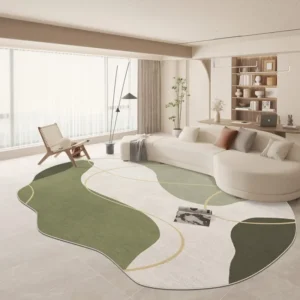 Large Area Green Rugs for Bedroom Nordic Living Room Decoration Shaped Carpet Irregular Plush Lounge Rug Home Thick Washable Mat
Rated 5.00 out of 5$54.94 – $346.41Price range: $54.94 through $346.41
Large Area Green Rugs for Bedroom Nordic Living Room Decoration Shaped Carpet Irregular Plush Lounge Rug Home Thick Washable Mat
Rated 5.00 out of 5$54.94 – $346.41Price range: $54.94 through $346.41 -
 Nordic Style Rugs for Bedroom Morandi Living Room Decoration Carpet Large Area Geometry Lounge Rug Home Cloakroom Non-slip Mat
Rated 5.00 out of 5$39.46 – $597.66Price range: $39.46 through $597.66
Nordic Style Rugs for Bedroom Morandi Living Room Decoration Carpet Large Area Geometry Lounge Rug Home Cloakroom Non-slip Mat
Rated 5.00 out of 5$39.46 – $597.66Price range: $39.46 through $597.66 -
 Irregular Shapes Living Room Decoration Carpet Modern Style Rugs for Bedroom Home Thicken Plush Rug Fluffy Soft Lounge Floor Mat
Rated 4.85 out of 5$55.84 – $347.37Price range: $55.84 through $347.37
Irregular Shapes Living Room Decoration Carpet Modern Style Rugs for Bedroom Home Thicken Plush Rug Fluffy Soft Lounge Floor Mat
Rated 4.85 out of 5$55.84 – $347.37Price range: $55.84 through $347.37

